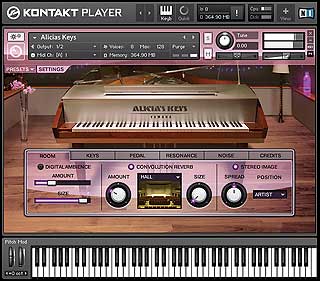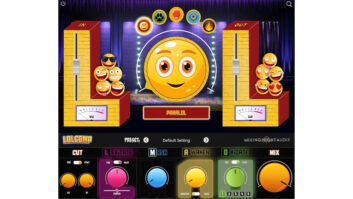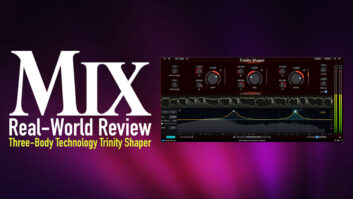
Each note of Alicia Keys’ piano was sampled in 12 layers, including pedals and resonance.
For some artists, taking the creative bubble of the studio on the road is as simple as packing up some drums, guitars and amps and using the same instruments live that are on the record. However, for an artist like Alicia Keys, whose favorite instrument is a limited-edition grand piano, this is impractical if not damaging to the instrument. So Keys, her engineer Ann Mincieli, Danish sample specialist Thomas Skarbye (better known as Scarbee) and impulse response expert Ernest Cholakis created Alicia’s Keys. This virtual instrument, released by Native Instruments in early March, is sampled from Keys’ own playing in her Oven Studios.
Keys explains the necessity of creating a virtual piano that suited her style and taste: “I’ve played a lot of sampled pianos, which is why I knew I had to create one of my own,” she says. “Honestly, to me, all of the others fall short. And I’m not just saying that because it’s mine.” Engineer Mincieli then contacted Skarbye and proposed the idea that Keys come up with her own piano.
Keys’ studio piano is a Yamaha C3 Neo, an anniversary edition made in 2001. The artist was heavily involved in the process from the start and wanted to be sure that the end result reflected her own unique instrument and style. According to Mincieli, “We studied the way Alicia plays and then sampled 12 layers (per note); pedal up, pedal down, sustain, resonating samples and pedal noises to create her virtual piano.”
Capturing the Essence
Mincieli, who has been working with Keys for 11 years, tried a lot of combinations of mics to get the right recordings of the samples: “I had a stereo [Telefunken] ELAM 270 [tube] mic going through Quad 8 mic preamps, two U87s going through Shadow Hills mic pre’s and a pair of AKG 414s through Neve 1073 mic pre’s.” From there, the audio was taken directly into Pro Tools through Digidesign HD 192 interfaces at 44.1/24-bit resolution. Rather than use any processing, Mincieli used old-school techniques to get the sound right. “I wanted to keep the natural integrity of the sound and let the user be able to tweak it,” she says. “We spent days chasing the right mic placement instead of EQ’ing. That’s what it’s all about—the right mic pre, the right microphone and the right mic placement.” Finally, the team decided to go with the two mics that sounded best: the 414s through the Neve preamps. “[The mics were] a foot away from the high and low, right above the strings. We got a nice picture of the chamber and the hammers hitting the strings,” she recalls.
As the samples were being recorded, Mincieli and Skarbye cleaned up the tracks as necessary. “On the lower velocities, at -35 dB, you start hearing noise,” Mincieli says. “No matter how quiet a control room or live room you have, you have to eliminate it.” The issue with a sampled collection is the cumulative effect of the noise floor. “If you have noise on one sample and then sometimes hit three or four keys at once, it can be multiplied,” she continues. They relied heavily on the Waves Restoration bundle and Dolby noise-reduction software to do the job.
After the samples were recorded, edited and cleaned, they were put into the control map. “You use the control mapping to assign a sample to play at 0 to 10 velocity, then from 10 to 20 [and so on], then crossfade between them so it’s seamless,” Mincieli explains. There were also considerations about how different controllers would play the samples. “It’s really tricky,” she says. “Every controller, whether it’s Fatar, Phantom, M-Audio or Motif, all seemed to trigger just a little differently. Some of them only go down to 8 (velocity) so you’re not getting that first sample all the way.” Because of this, the team had to adjust the control mapping to accommodate a variety of different controllers.
Keys is now on tour and using a Muse Receptor as a home for the plug-in, which is triggered via MIDI from a Yamaha grand piano onstage. “The touch is beautiful, it’s very responsive,” says Keys. “We even sampled the noise that the pedal makes when you release it so it has the authenticity of a real piano.” Branded plug-ins from well-known names in the industry were first introduced on the engineering/processor side by Waves, but is there an interest in a virtual instrument from the mind and hands of a successful recording artist? If the first day’s buzz created via YouTube, Native Instruments and Keys’ Websites, along with a single tweet to her 1.25 million Twitter followers is any indication, then the answer is yes. “The day we put [the product video] up on YouTube,” Mincieli says, “it got 80,000 views.”
The Alicia’s Keys runs on Mac or PC and is available now from Native Instruments; retail is $119.




